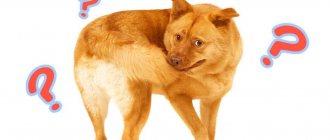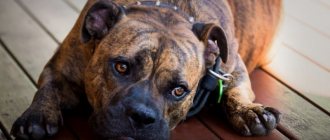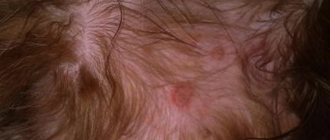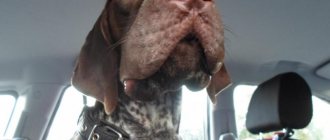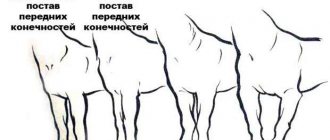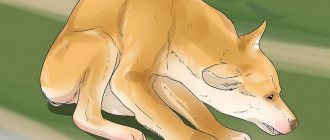We specify the location of the deployment
Neoplasms can appear on any part of the body - limbs, forehead, back. Most often, a lump is noticed on a dog’s stomach in areas not covered by hair. This is facilitated by softer tissues compared to other parts of the body.
Having felt the tubercle in one place, it is necessary to completely examine the peritoneum of the animal.
Particular attention is paid to the following areas:
- areas around the navel;
- midline of the abdomen (center between the nipples);
- mammary glands in a female.
It is important to determine not only the location of the lump. They try to feel how deep it sits under the skin, whether it has affected muscle tissue. The density of the bud also matters.
Expert opinion
Panteleeva Irina Petrovna
Breeder, 11 years experience.
Be sure to examine the skin around the seal to exclude the presence of an inflammatory process and promptly detect dermatological problems.
Reasons, each of which can lead to compaction at the site of damage:
injury or severe bruise;- insect bites;
- circulatory disorders;
- diseases of a viral or bacterial nature.
Oncological pathologies also lead to the formation of lumps and pose a serious danger to the animal.
But only a specialist can determine the true cause after a series of studies.
Diagnosis by the appearance of the lump
Determining the nature and cause of a swelling on a dog’s paw is best left to specialists who, based on the results of a comprehensive examination, prescribe appropriate treatment. The owner of the animal at home can make a preliminary diagnosis based on the appearance of the lump.
Red
A red swelling is characteristic of the initial stage of an abscess, cancer formation, boil, or local inflammatory reaction to an injection or insect bite.
Determining the type of tumor
Cones have a different nature, which determines their appearance.
The most common of these is swelling at the site of a flea or other blood-sucking insect bite. Sometimes an ixodid tick that has penetrated into the dermis is mistaken for a neoplasm. Experts divide the remaining seals into 2 types - non-oncological and malignant.
Benign formations
| Name | Peculiarities |
| Warts, papillomas | Characteristic of representatives of smooth-haired breeds. The reason lies in a viral infection. The growths do not cause pain, but they are a reason for examination |
| Cysts | Visually, the swelling is difficult to notice - a hard lump is accidentally encountered while bathing the animal or stroking it |
| Pyoderma | The pathology most often occurs in puppies. A timely visit to a doctor will help relieve your pet from severe pain. The danger of the disease is that it disrupts the functioning of the gonads. In an advanced state, purulent discharge from the cone is observed. The swelling itself tends to spread to other areas of the body |
| Hematoma | The convex lump is soft to the touch, red and consists of fluid accumulated there. The reason lies in injury or fragility of blood vessels |
The site of injury due to a bite or injury may become infected. Bacteria that enter tissues cause infection. The abscess develops gradually, turning into a noticeable compaction, while the animal’s body temperature rises sharply.
Oncology
Cancer is not often diagnosed in dogs.
Females are at risk: their malignant tumors are usually localized on the mammary glands.
Tumors of this type can be divided into 2 types:
- some “sit” in place;
- others spread throughout the body (metastasis).
Metastases involve not only epidermal tissue, but also blood vessels, muscles, and penetrate vital organs. One of the signs of oncology is bleeding caused by rupture of the skin at the site of formation.
Reasons for appearance
Education occurs as a result of injury or serious pathological processes in the body.
The diagnosis is made after instrumental examination methods and laboratory tests.
Causes and symptoms:
- Injuries, mechanical damage. Occur due to minor or serious bruises. If the lump is located only on the surface of the head, there is no need to worry. If vomiting or loss of consciousness occurs, damage to the skull or concussion is ruled out.
Insect bites. Inflammation, swelling, and allergies develop. The animal may develop Quincke's edema, anaphylactic shock, urticaria, and other systemic abnormalities.- Bacterial, viral infection. Damage occurs on the scalp area. Bacteria or viruses penetrate there. An immune response is formed, soft tissues become inflamed and swell.
- Consequences of the operation. After the intervention, treatment is carried out for a long time. It is necessary to properly care for damaged tissues and treat them. At first, slight swelling appears, which goes away with proper care. Otherwise, a bacterial infection develops and pus accumulates under the skin.
- Oncological diseases. A malignant neoplasm can be localized on any part of the head. The owners confuse the disease with a bruise. If the lump does not go away for a long time, contact the veterinarian. He does tissue biopsy and histology. When atypical cells are detected, cancer is diagnosed.
The listed types of damage require treatment. It is not carried out independently. Only a doctor can determine the cause and methods of therapy.
Foreign body stuck in soft tissue
If touching the lump causes pain in your pet, you need to carefully examine the problem area. Perhaps a splinter or other foreign object has gotten into the tissue. Confirmation of this is obvious punctures on the skin, a bleeding wound, and redness of the dermis.
A pet could “pick up” a foreign body while walking, having stumbled upon a sharp branch, a large thorn, or a steel wire.
First aid
Having discovered damage, the owner should not remove the item himself, even if part of it sticks out.
This will lead to infection of the wound, and if the body penetrates deeply, it will cause bleeding. The only thing that is allowed is treating the problem area with Chlorhexidine or Hydrogen Peroxide. After this, the dog is immediately shown to a veterinarian to eliminate the problem (after a preliminary examination).
What to do if you discover a problem?
If you find a lump on an animal’s head, then first of all you need to carefully examine and feel it. If the formation is painful for the animal, it is recommended to urgently show it to a doctor.
If the lump causes serious concern to the animal or other formations begin to appear over time, the veterinarian must first figure out what the cause of its occurrence is. In this case, one cannot do without an extensive list of studies, among which it is necessary to highlight:
- Radiography;
- Biopsy;
- Computed tomography;
- Taking a swab-imprint.
If the lump does not cause pain to the animal, does not secrete pus or change its color, the dog owner should observe the lump for many days. It is likely that such swelling will go away on its own. At the same time, you need to remember that you need to prohibit the animal from licking the area in the area of inflammation, as this may cause the occurrence of granuloma. If the formation begins to change, it is necessary to urgently show the dog to a doctor.
Bruise, injury
During a rough game, a fight, or jumping from a height, dogs often receive bruises and injuries of varying severity. Even minor damage can lead to hematoma and hard lump formation.
At the site of impact, the color of the skin changes and abrasions are possible. Touching a bruise causes pain in your pet.
How can I help you
For minor injuries, to alleviate the animal's suffering, apply a cold compress to the site of the bruise.
To do this, it is recommended to use a rubber heating pad with frozen liquid (in winter - snow from the street) or a regular cotton napkin moistened with cold water. If a serious injury is suspected, the dog is taken to a veterinary clinic. After x-rays, the specialist prescribes heating and alcohol-containing dressings if there are no fractures. Otherwise, surgery will be required.
Hernia: is it dangerous or not?
The cause of the problem lies in the displacement of the intestines from the peritoneum. The pathology can be congenital or acquired. The protrusion most often appears in the navel area.
If, due to weakness of the muscles, the puppy’s ring is not completely overgrown, then later, with strong tension in the abdomen, a small section of the intestine ends up in the hole.
As a result of injury, a hernial lump can be found in the groin, on the abdomen in the pelvic area or in the thigh area.
Classification of pathology:
- non-strangulated hernia (soft to the touch and easily retractable);
- pinched - dense, swollen.
The latter cannot be moved into place - this will cause severe pain in the dog. Yes, and a protruding organ can be damaged. All manipulations should be done only by a specialist.
Risk of entrapment
An unreducible hernia requires urgent surgical intervention. Otherwise, blood will stop flowing into the pinched area. This leads to tissue necrosis, sepsis and painful death of the pet.
Oncological disease
Malignant neoplasms most often develop in bitches in the mammary glands.
Main reasons:
- taking hormonal medications to prevent conception;
- untimely sterilization with removal of the ovaries and uterus;
- bruises of the mammary glands;
- severe mastitis.
Nulliparous females who have reached adulthood are at high risk of developing cancer.
The first signs that cannot be ignored
Regular examination of a dog’s mammary glands (regardless of age and status) is a must in caring for an animal.
Careful palpation of the tissues of dairy beds allows you to promptly detect a scattering of small “peas”.
Each such grain without treatment quickly turns into a lump. If the results of the examination confirm its oncological nature, serious treatment will be required, which does not exclude surgical intervention .
Dog treatment
The technique of surgical operations can be different:
- Total mastectomy (removal of the entire ridge of mammary glands ).
- Local removal.
- Resection with extensive involvement of surrounding tissue, for example with mastocytoma.
- Opening the abscess and installing a drainage system.
- Suturing the hernia with removal of necrotic tissue, if any.
Therapeutic treatment is performed in cases where, for one reason or another, surgery is impossible or preliminary drug preparation is required before surgery.
Also, after resection of some tumors, chemotherapy is required to reduce the risk of relapse.
Diagnostics for oncological problems
Regardless of the reason for the formation of a lump on the dog’s abdominal area, the pet must be thoroughly examined. This is especially important for cancer: diagnosis helps determine the type and degree of danger of the tumor.
The following procedures are prescribed:
- biochemical and general blood tests;
biopsy for histology (fluid is taken from the lump using a syringe);- rectal and ultrasound examination of lymph nodes;
- chest x-ray to determine the presence of metastases;
- radiography, which allows you to clarify the depth of penetration into soft tissues;
- CT scan (helps to identify the malignancy of the tumor).
If the tumor is benign, it is removed surgically. This cannot be done during the process of metastasis. But conventional treatment with medications will not help here. Malignant pathology is “treated” with radiation and chemotherapy.
Prevention measures
Most problems that cause lumps in dogs can be avoided if preventive measures are taken early. Your pet needs to be given maximum attention and care.
Recommendations that will help keep your pet healthy, identify the disease at an early stage and choose the right treatment if pathology is detected:
- regular checkups with a veterinarian;
- compliance with the vaccination schedule;
- careful selection of places for walking and training the dog in order to eliminate the risk of injury or infestation of the animal with parasites;
- avoiding close contact with stray animals to avoid the risk of contracting infections
- daily examination of the mammary glands of bitches;
timely treatment (especially diseases of the genital area);- balanced diet to improve immunity.
If the dog was not brought in to produce offspring from it, then it is more humane to sterilize the animal surgically, choosing the optimal age for this - 6 months from the moment of birth.
In this case, the risk of developing cancer is less than when controlling the sexual instinct with hormonal drugs.
What to do at home if your dog has a lump?
If a pink or colorless lump is suddenly noticed on your dog, it should be carefully examined and palpated, after thoroughly washing your hands with soap. Such manipulations can bring unpleasant sensations to the pet. In this case, you cannot do without consulting a doctor to find out how to treat the disease.
The animal will try to lick or even chew the sore spot. This should not be allowed, otherwise there will be a risk of developing a granuloma - a hard node from an accumulation of connective tissue.
